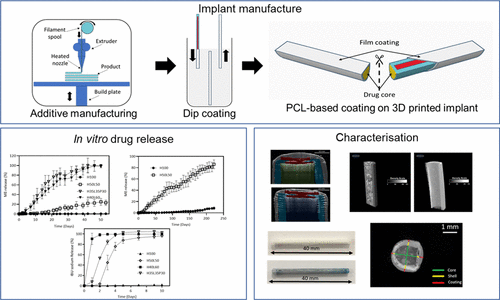当前位置:
X-MOL 学术
›
Mol. Pharmaceutics
›
论文详情
Our official English website, www.x-mol.net, welcomes your feedback! (Note: you will need to create a separate account there.)
Poly(caprolactone)-Based Coatings on 3D-Printed Biodegradable Implants: A Novel Strategy to Prolong Delivery of Hydrophilic Drugs.
Molecular Pharmaceutics ( IF 4.9 ) Pub Date : 2020-07-16 , DOI: 10.1021/acs.molpharmaceut.0c00515 Sarah A Stewart 1 , Juan Domínguez-Robles 1 , Victoria J McIlorum 1 , Zoilo Gonzalez 2 , Emilia Utomo 1 , Elena Mancuso 3 , Dimitrios A Lamprou 1 , Ryan F Donnelly 1 , Eneko Larrañeta 1
Molecular Pharmaceutics ( IF 4.9 ) Pub Date : 2020-07-16 , DOI: 10.1021/acs.molpharmaceut.0c00515 Sarah A Stewart 1 , Juan Domínguez-Robles 1 , Victoria J McIlorum 1 , Zoilo Gonzalez 2 , Emilia Utomo 1 , Elena Mancuso 3 , Dimitrios A Lamprou 1 , Ryan F Donnelly 1 , Eneko Larrañeta 1
Affiliation

|
Implantable devices are versatile and promising drug delivery systems, and their advantages are well established. Of these advantages, long-acting drug delivery is perhaps the most valuable. Hydrophilic compounds are particularly difficult to deliver for prolonged times. This work investigates the use of poly(caprolactone) (PCL)-based implant coatings as a novel strategy to prolong the delivery of hydrophilic compounds from implantable devices that have been prepared by additive manufacturing (AM). Hollow implants were prepared from poly(lactic acid) (PLA) and poly(vinyl alcohol) (PVA) using fused filament fabrication (FFF) AM and subsequently coated in a PCL-based coating. Coatings were prepared by solution-casting mixtures of differing molecular weights of PCL and poly(ethylene glycol) (PEG). Increasing the proportion of low-molecular-weight PCL up to 60% in the formulations decreased the crystallinity by over 20%, melting temperature by over 4 °C, and water contact angle by over 40°, resulting in an increased degradation rate when compared to pure high-molecular-weight PCL. Addition of 30% PEG to the formulation increased the porosity of the formulation by over 50% when compared to an equivalent PCL-only formulation. These implants demonstrated in vitro release rates for hydrophilic model compounds (methylene blue and ibuprofen sodium) ranging from 0.01 to 34.09 mg/day, depending on the drug used. The versatility of the devices produced in this work and the range of release rates achievable show great potential. Implants could be specifically developed in order to match the specific release rate required for a number of drugs for a wide range of conditions.
中文翻译:

3D 打印的可生物降解植入物上基于聚己内酯的涂层:延长亲水性药物递送的新策略。
植入式装置是一种用途广泛、前景广阔的药物输送系统,其优点是众所周知的。在这些优点中,长效药物输送可能是最有价值的。亲水性化合物特别难以长时间递送。这项工作研究了使用基于聚己内酯 (PCL) 的植入涂层作为一种新策略,以延长增材制造 (AM) 制备的植入设备中亲水化合物的输送时间。使用熔丝制造 (FFF) AM 由聚乳酸 (PLA) 和聚乙烯醇 (PVA) 制备中空植入物,然后涂上基于 PCL 的涂层。涂层是通过不同分子量的 PCL 和聚乙二醇 (PEG) 的溶液浇铸混合物制备的。将配方中低分子量PCL的比例提高至60%,结晶度降低20%以上,熔融温度降低4℃以上,水接触角降低40°以上,降解率较相比有所提高到纯的高分子量PCL。与同等的纯 PCL 配方相比,在配方中添加 30% PEG 可使配方的孔隙率增加 50% 以上。这些植入物的亲水性模型化合物(亚甲基蓝和布洛芬钠)的体外释放率范围为 0.01 至 34.09 毫克/天,具体取决于所使用的药物。这项工作中生产的设备的多功能性和可实现的释放速率范围显示出巨大的潜力。可以专门开发植入物,以匹配多种药物在各种条件下所需的特定释放速率。
更新日期:2020-09-09
中文翻译:

3D 打印的可生物降解植入物上基于聚己内酯的涂层:延长亲水性药物递送的新策略。
植入式装置是一种用途广泛、前景广阔的药物输送系统,其优点是众所周知的。在这些优点中,长效药物输送可能是最有价值的。亲水性化合物特别难以长时间递送。这项工作研究了使用基于聚己内酯 (PCL) 的植入涂层作为一种新策略,以延长增材制造 (AM) 制备的植入设备中亲水化合物的输送时间。使用熔丝制造 (FFF) AM 由聚乳酸 (PLA) 和聚乙烯醇 (PVA) 制备中空植入物,然后涂上基于 PCL 的涂层。涂层是通过不同分子量的 PCL 和聚乙二醇 (PEG) 的溶液浇铸混合物制备的。将配方中低分子量PCL的比例提高至60%,结晶度降低20%以上,熔融温度降低4℃以上,水接触角降低40°以上,降解率较相比有所提高到纯的高分子量PCL。与同等的纯 PCL 配方相比,在配方中添加 30% PEG 可使配方的孔隙率增加 50% 以上。这些植入物的亲水性模型化合物(亚甲基蓝和布洛芬钠)的体外释放率范围为 0.01 至 34.09 毫克/天,具体取决于所使用的药物。这项工作中生产的设备的多功能性和可实现的释放速率范围显示出巨大的潜力。可以专门开发植入物,以匹配多种药物在各种条件下所需的特定释放速率。



























 京公网安备 11010802027423号
京公网安备 11010802027423号